Researchers at Lund University in Sweden have reconstructed meteorite bombardment towards Earth over the past 500 million years and found that despite major collisions between huge rocky bodies in the asteroid belt, impacts on Earth have not been greatly affected; a result that bodes well for the preservation of life on our planet.
It is estimated that around two thousand meteorites land on the Earth's surface every year, and as many as 63,000 of them have been documented by science.
While most go unnoticed, some can cause considerable damage, such as the 10 kilometre sized rock that hit the Yucatán Peninsula 66 million years ago that is thought to be behind the demise of the dinosaurs – thankfully these types of impact are rare
Large or small, the standard view of meteorite delivery to Earth is that large asteroid break-ups scattered throughout the asteroid belt between Mars and Jupiter generate new rocky fragments which eventually find their way to our planet over an extended period.
Not quite so, say two researchers based in Sweden, who in a new study have tracked the meteorite flux to Earth from the Cambrian to the present.
To conduct the study, Birger Schmitz and Fredrik Terfel at Lund University dissolved almost ten tonnes of sedimentary rocks from ancient seabeds in strong acids to sift out tiny fragments of meteorites.
Scientists can identify outer space particles as they contain a very small fraction of chromium oxide, a mineral that is very resistant to degradation.
And depending where they lay in the rock record, they can serve as tiny time capsules as they can be dated back to when they fell to Earth.
"The dissolved sediment represents 15 periods over the past 500 million years. In total, we have extracted chromium oxide from almost 10 000 different meteorites. Chemical analyses then enabled us to determine which types of meteorites the grains represent", says Schmitz, a professor of geology at Lund.
Their results suggest that while the asteroid belt is still the main source of meteorites that head our way, only one huge collision appears to have given rise to a strongly enhanced flux to Earth.
"We were very surprised to learn that only one of the 70 largest asteroid collisions that took place over the past 500 million years resulted in an increased flux of meteorites to Earth. For some reason, most of the rocks stay in the asteroid belt", says Schmitz.
Terfel and Schmitz’s study not only overturns generally accepted meteorite flux theories, it also provides a new perspective on where in the solar system celestial bodies that are at greatest risk of colliding with Earth originate from.
“We argue that meteorites and small asteroids delivered to Earth in deep time are not primarily linked to the sequence of asteroid family-forming events,” say the authors in their research paper recently published in the Proceedings of the National Academy of Sciences (PNAS) journal. “Another, as yet unknown, delivery process appears to be associated with a very restricted region in the asteroid belt,” they add.











